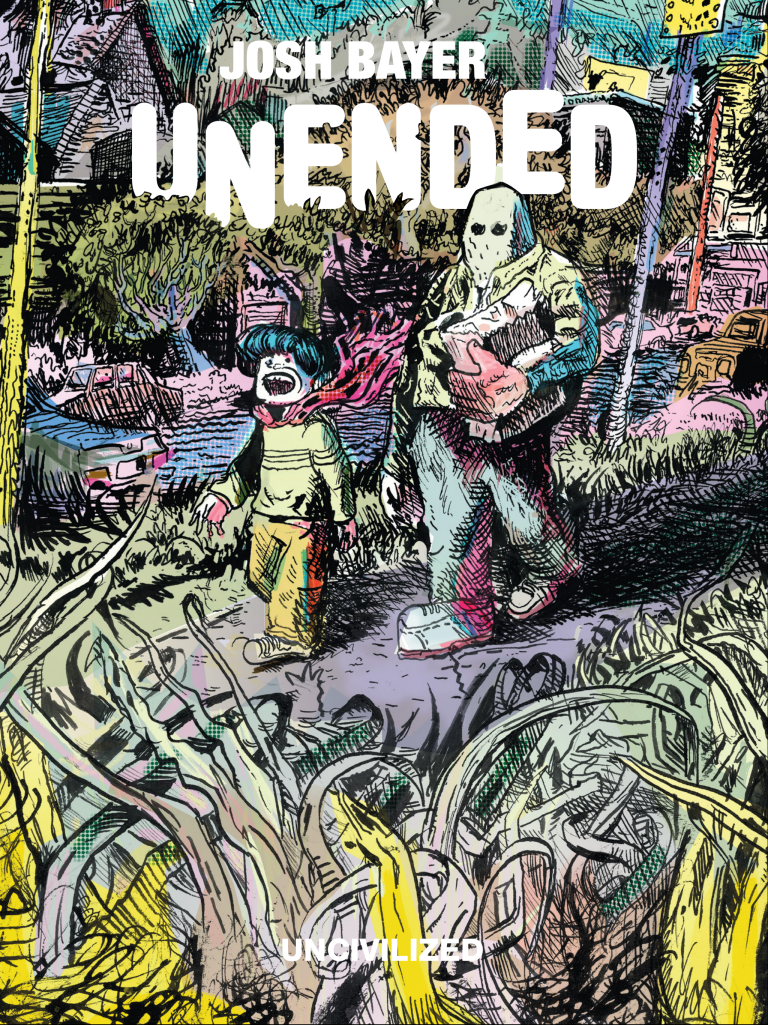In Masters of the Nefarious: Mollusk Rampage, pseudonymous multi-hyphenate Pierre La Police, who’s been kicking around the French comics scene for more than 30 years now, manages to pull off a trick that’s a lot more impressive than it might initially sound: he creates a comic that’s a 162-page narrative but consists of pages set up as if they are single-page gags. Of course, I say it’s a narrative, but that’s me falling for the trick; the narrative itself is as absurd as the panels that make it up, and maybe it’s not so hard to pull off considering that its many enigmas, contradictions, mysteries and conundrums are dismissed with the storytelling equivalent of a shrug.
The plot, if you want to call it that–and why wouldn’t you?–involves the titular Masters of the Nefarious, a trio of violent and chaotic supernatural investigators: hydrocephalic mutant twin brothers Chris and Montgomery Themistecles and grotty decaying weirdo Fongor Fonzym. They take it upon themselves to look into the appearance of a wave of mystical, murderous squid-like beings that wash up after a tidal wave in the South Pacific. This is just the nominal throughline of the book, though, and falling for it like it’s a real story is playing right into one of La Police’s best gags; there’s really nothing here but one semi-connected joke after another, and even the most basic desire for it to add up to something is mocked in the book. Trying to impose meaning on such a wild stream of disjointed, ridiculous vignettes is as irresistible as it is impossible.
But while Masters of the Nefarious is definitely absurdist, it’s not entirely absurd; the ‘story’ has a beginning, an ending, and a very long and very malleable middle. It also doesn’t take the approach of so many surreal humor comics of being composed entirely of bits and pieces that are just completely random; every panel-to-panel transition seems like it means something, right up until the point that it absolutely does not. This is one of La Police’s best qualities as a cartoonist. You’re led down a path that looks like it’s going to bring some structure to the whole thing, only for it to divulge at exactly the right moment into some hilarious tangent that goes nowhere, but still maintains the barest of threads connecting it to where you thought it was going to go.
If I haven’t been clear enough, Masters of the Nefarious is very, very funny. It’s not subtle or clever; its humor is big and weird and more than a little stupid. But at least one in every five panels had me laughing out loud and trying with no success to explain to my wife what was so funny. It bears some of the DNA of The Far Side (albeit a bit more polished visually, in a way that complements its sensibilities) and maybe even a little more of David Lynch’s experiments in the medium, but what makes the book unique is how well it succeeds at its primary trick. While there’s a few single panels that could be extracted and presented on their own and still be successful as gag strips, many, if not most, rely on what comes before and will appear after. It’s wrong to say the throughline affords them more sense–which is not something that La Police is going for here, and wouldn’t make the book any better–but appearing as they do in the flow of the story gives them a context that renders the gags even more effective.
It's always a bit hard to review a humor comic without giving away the best jokes, or, even worse, explaining them; nothing drains the joy out of comedy than a dry description of a visual gag. But for the sake of flavor, I’ll drop a few of my favorite moments to give a sense of what we’re dealing with here. There’s moments of casual violence that explode with the power of great slapstick, as when Fongor attacks a fellow passenger on a transatlantic flight for grating nutmeg in the aisle; Chris is always being distracted at critical moments in the ‘plot’ by penis enlargement ads or the inability to select just the right pair of pants; Montgomery dies and is resurrected for no particular reason, twice.
One of the thorniest things about this style of low absurdism is, as noted, the risk that it will just degenerate into random nonsense, and one reason why Masters of the Nefarious is such a success on its own terms is that it manages to sidestep this temptation at almost every turn. The translator, Luke Burns, discusses this at some length in the book’s enjoyable afterword, calling particular attention to the compounded difficulty of making this type of humor effective in a different language. He shouldn’t worry; the translation is both skillfully done and more than simpatico with La Police’s vision. Even within the western canon, foreign-language humor can lose a lot in the cultural transition, but, to steal Mel Brooks’ concept, La Police’s work here rises below the vulgarity of mere translation.
The comics imprint of New York Review Books is developing a reputation in harmony with its parent: the discovery and promotion of both historically overlooked work and underappreciated contemporary literature. Masters of the Nefarious may seem a bit lowbrow, but it actually fits like a glove; it’s strange and wonderful, terrifically funny, and largely unlike anything else coming out of the scene at the moment. At the price, it’s both more than worthwhile and a very quick and satisfying read thanks to the narrative line, however silly and arbitrary it actually is. Some of the panels are as transcendent as Goya and as funny as a random still from Pee Wee’s Playhouse.













